Ethical Leadership: Moral Development, Decision-Making, and Tools
VerifiedAdded on 2020/03/16
|8
|1826
|49
Essay
AI Summary
This essay explores the multifaceted dimensions of ethical leadership, focusing on moral development and effective decision-making processes. It introduces various diagnostic tools, including the MCI score, self-reflection techniques (SLPS), value score assessments, and self-awareness questionnaires, to evaluate and enhance ethical leadership capabilities. The essay emphasizes the importance of personal ethics, values, and principles in shaping successful leadership, highlighting the need for transparency, self-awareness, and balanced processing. Furthermore, it examines how observation, reflection, and evaluation influence ethical behavior and decision-making. The author draws on the works of Bennis, Ciulla, Conger, Guy, Hamilton, Holland, Knapp, Lozano, Price, Sergiovanni, and Shull to support the arguments and provides a comprehensive overview of how ethical leaders should embrace moral development for organizational success.
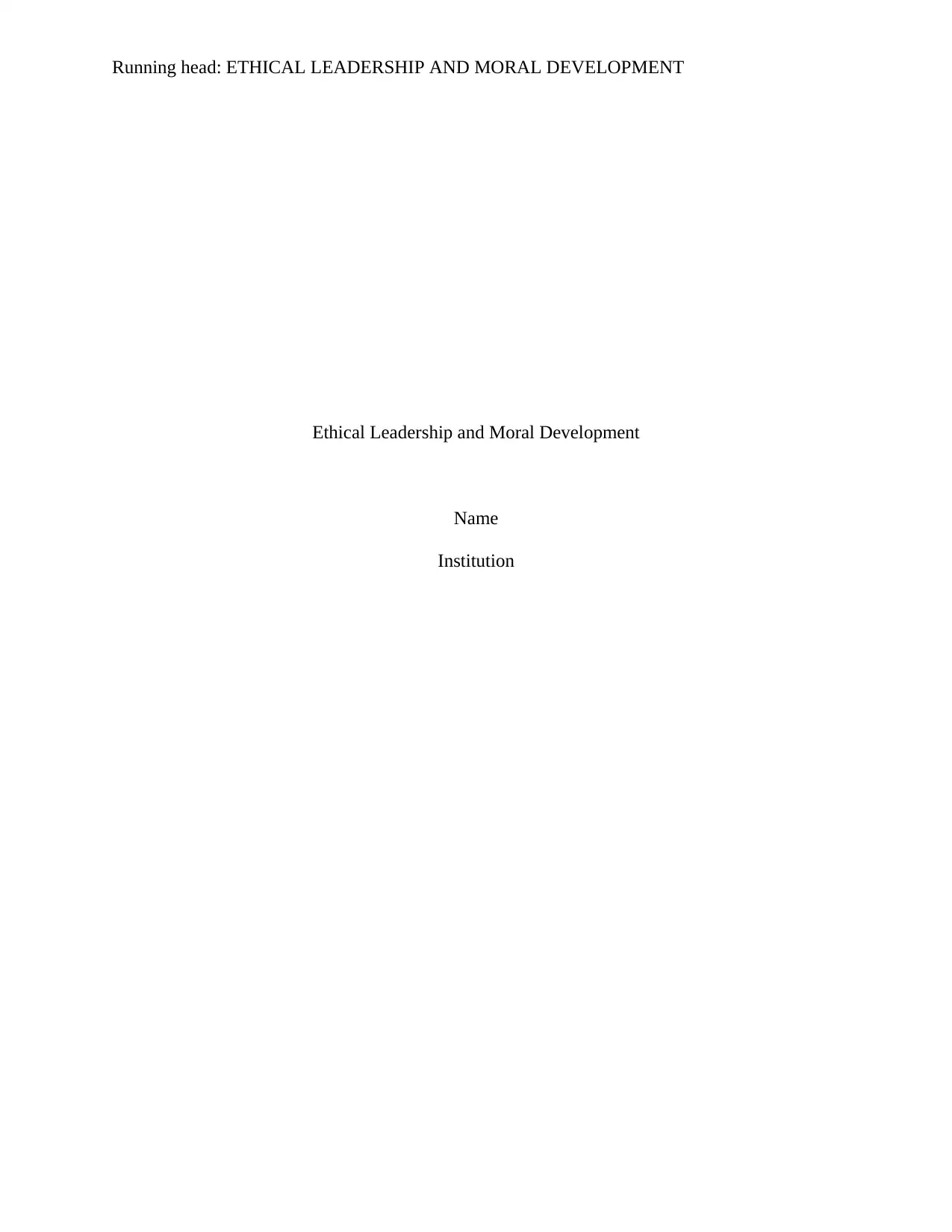
Running head: ETHICAL LEADERSHIP AND MORAL DEVELOPMENT
Ethical Leadership and Moral Development
Name
Institution
Ethical Leadership and Moral Development
Name
Institution
Paraphrase This Document
Need a fresh take? Get an instant paraphrase of this document with our AI Paraphraser
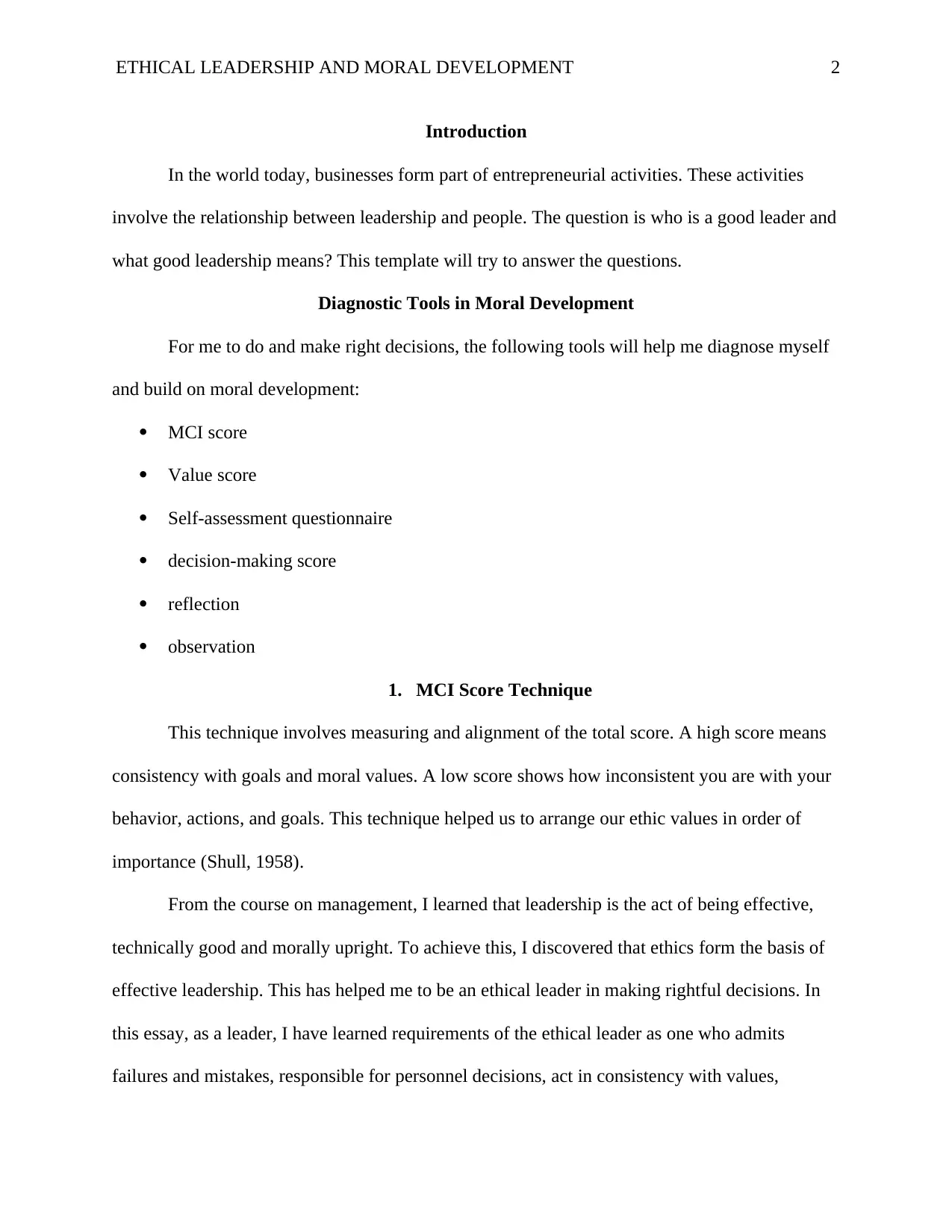
ETHICAL LEADERSHIP AND MORAL DEVELOPMENT 2
Introduction
In the world today, businesses form part of entrepreneurial activities. These activities
involve the relationship between leadership and people. The question is who is a good leader and
what good leadership means? This template will try to answer the questions.
Diagnostic Tools in Moral Development
For me to do and make right decisions, the following tools will help me diagnose myself
and build on moral development:
MCI score
Value score
Self-assessment questionnaire
decision-making score
reflection
observation
1. MCI Score Technique
This technique involves measuring and alignment of the total score. A high score means
consistency with goals and moral values. A low score shows how inconsistent you are with your
behavior, actions, and goals. This technique helped us to arrange our ethic values in order of
importance (Shull, 1958).
From the course on management, I learned that leadership is the act of being effective,
technically good and morally upright. To achieve this, I discovered that ethics form the basis of
effective leadership. This has helped me to be an ethical leader in making rightful decisions. In
this essay, as a leader, I have learned requirements of the ethical leader as one who admits
failures and mistakes, responsible for personnel decisions, act in consistency with values,
Introduction
In the world today, businesses form part of entrepreneurial activities. These activities
involve the relationship between leadership and people. The question is who is a good leader and
what good leadership means? This template will try to answer the questions.
Diagnostic Tools in Moral Development
For me to do and make right decisions, the following tools will help me diagnose myself
and build on moral development:
MCI score
Value score
Self-assessment questionnaire
decision-making score
reflection
observation
1. MCI Score Technique
This technique involves measuring and alignment of the total score. A high score means
consistency with goals and moral values. A low score shows how inconsistent you are with your
behavior, actions, and goals. This technique helped us to arrange our ethic values in order of
importance (Shull, 1958).
From the course on management, I learned that leadership is the act of being effective,
technically good and morally upright. To achieve this, I discovered that ethics form the basis of
effective leadership. This has helped me to be an ethical leader in making rightful decisions. In
this essay, as a leader, I have learned requirements of the ethical leader as one who admits
failures and mistakes, responsible for personnel decisions, act in consistency with values,
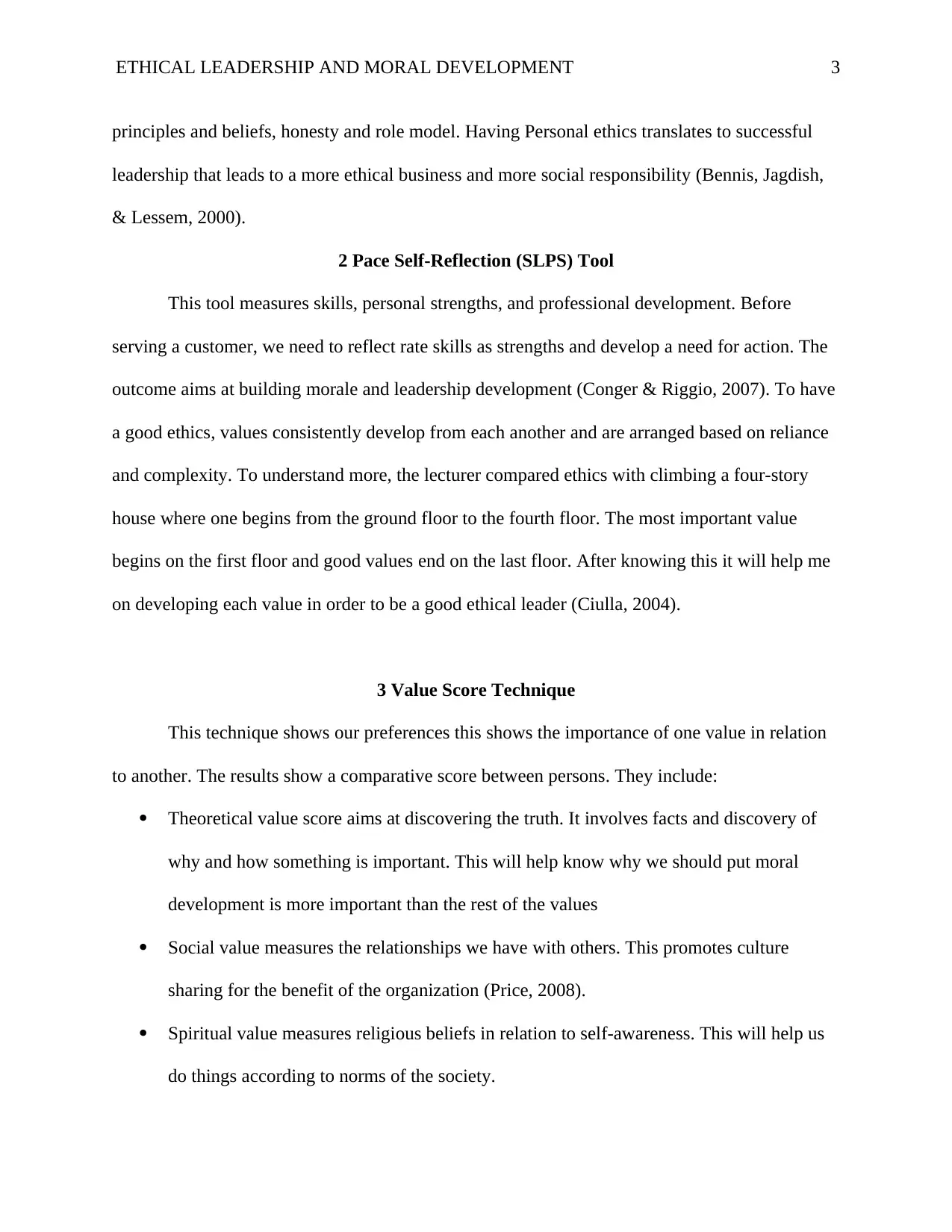
ETHICAL LEADERSHIP AND MORAL DEVELOPMENT 3
principles and beliefs, honesty and role model. Having Personal ethics translates to successful
leadership that leads to a more ethical business and more social responsibility (Bennis, Jagdish,
& Lessem, 2000).
2 Pace Self-Reflection (SLPS) Tool
This tool measures skills, personal strengths, and professional development. Before
serving a customer, we need to reflect rate skills as strengths and develop a need for action. The
outcome aims at building morale and leadership development (Conger & Riggio, 2007). To have
a good ethics, values consistently develop from each another and are arranged based on reliance
and complexity. To understand more, the lecturer compared ethics with climbing a four-story
house where one begins from the ground floor to the fourth floor. The most important value
begins on the first floor and good values end on the last floor. After knowing this it will help me
on developing each value in order to be a good ethical leader (Ciulla, 2004).
3 Value Score Technique
This technique shows our preferences this shows the importance of one value in relation
to another. The results show a comparative score between persons. They include:
Theoretical value score aims at discovering the truth. It involves facts and discovery of
why and how something is important. This will help know why we should put moral
development is more important than the rest of the values
Social value measures the relationships we have with others. This promotes culture
sharing for the benefit of the organization (Price, 2008).
Spiritual value measures religious beliefs in relation to self-awareness. This will help us
do things according to norms of the society.
principles and beliefs, honesty and role model. Having Personal ethics translates to successful
leadership that leads to a more ethical business and more social responsibility (Bennis, Jagdish,
& Lessem, 2000).
2 Pace Self-Reflection (SLPS) Tool
This tool measures skills, personal strengths, and professional development. Before
serving a customer, we need to reflect rate skills as strengths and develop a need for action. The
outcome aims at building morale and leadership development (Conger & Riggio, 2007). To have
a good ethics, values consistently develop from each another and are arranged based on reliance
and complexity. To understand more, the lecturer compared ethics with climbing a four-story
house where one begins from the ground floor to the fourth floor. The most important value
begins on the first floor and good values end on the last floor. After knowing this it will help me
on developing each value in order to be a good ethical leader (Ciulla, 2004).
3 Value Score Technique
This technique shows our preferences this shows the importance of one value in relation
to another. The results show a comparative score between persons. They include:
Theoretical value score aims at discovering the truth. It involves facts and discovery of
why and how something is important. This will help know why we should put moral
development is more important than the rest of the values
Social value measures the relationships we have with others. This promotes culture
sharing for the benefit of the organization (Price, 2008).
Spiritual value measures religious beliefs in relation to self-awareness. This will help us
do things according to norms of the society.
⊘ This is a preview!⊘
Do you want full access?
Subscribe today to unlock all pages.

Trusted by 1+ million students worldwide
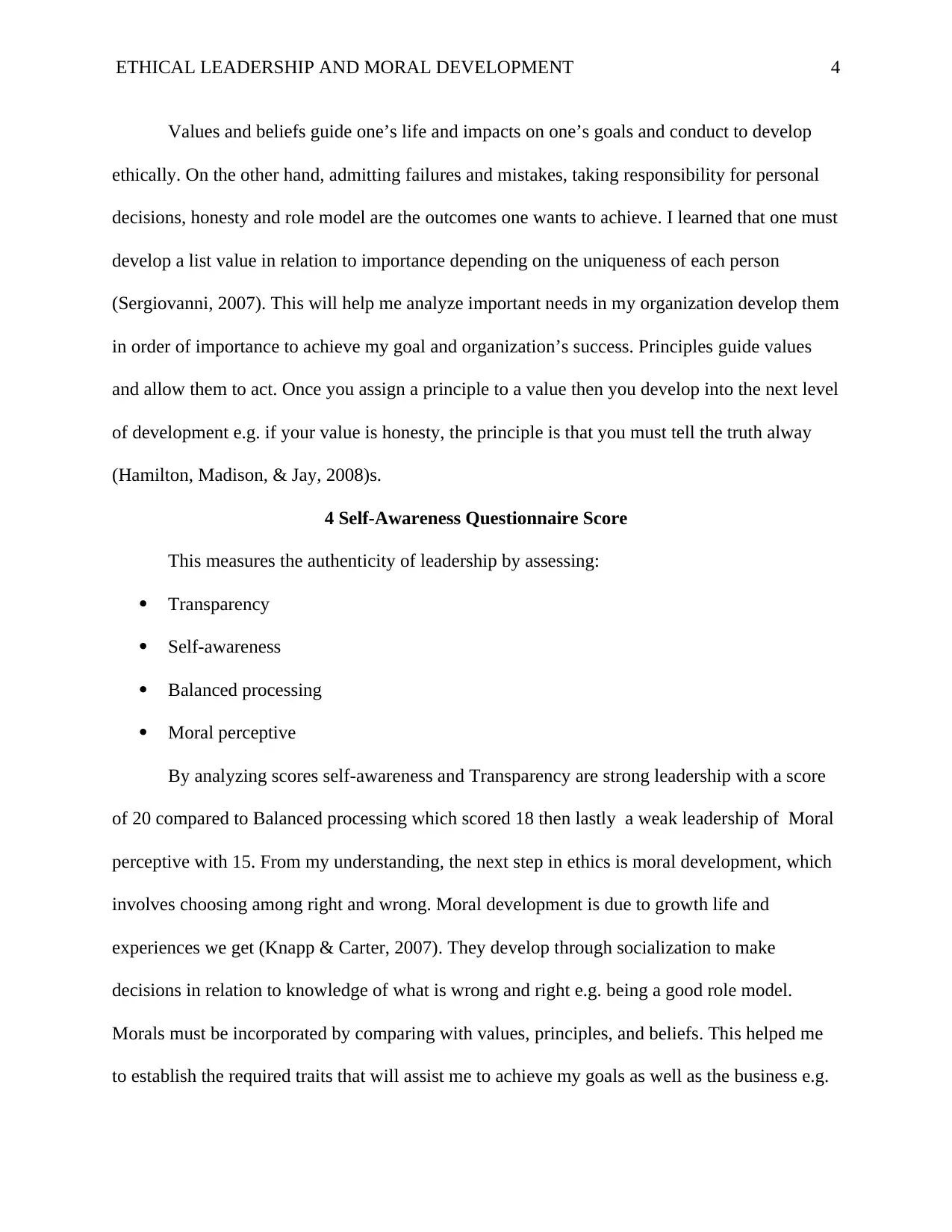
ETHICAL LEADERSHIP AND MORAL DEVELOPMENT 4
Values and beliefs guide one’s life and impacts on one’s goals and conduct to develop
ethically. On the other hand, admitting failures and mistakes, taking responsibility for personal
decisions, honesty and role model are the outcomes one wants to achieve. I learned that one must
develop a list value in relation to importance depending on the uniqueness of each person
(Sergiovanni, 2007). This will help me analyze important needs in my organization develop them
in order of importance to achieve my goal and organization’s success. Principles guide values
and allow them to act. Once you assign a principle to a value then you develop into the next level
of development e.g. if your value is honesty, the principle is that you must tell the truth alway
(Hamilton, Madison, & Jay, 2008)s.
4 Self-Awareness Questionnaire Score
This measures the authenticity of leadership by assessing:
Transparency
Self-awareness
Balanced processing
Moral perceptive
By analyzing scores self-awareness and Transparency are strong leadership with a score
of 20 compared to Balanced processing which scored 18 then lastly a weak leadership of Moral
perceptive with 15. From my understanding, the next step in ethics is moral development, which
involves choosing among right and wrong. Moral development is due to growth life and
experiences we get (Knapp & Carter, 2007). They develop through socialization to make
decisions in relation to knowledge of what is wrong and right e.g. being a good role model.
Morals must be incorporated by comparing with values, principles, and beliefs. This helped me
to establish the required traits that will assist me to achieve my goals as well as the business e.g.
Values and beliefs guide one’s life and impacts on one’s goals and conduct to develop
ethically. On the other hand, admitting failures and mistakes, taking responsibility for personal
decisions, honesty and role model are the outcomes one wants to achieve. I learned that one must
develop a list value in relation to importance depending on the uniqueness of each person
(Sergiovanni, 2007). This will help me analyze important needs in my organization develop them
in order of importance to achieve my goal and organization’s success. Principles guide values
and allow them to act. Once you assign a principle to a value then you develop into the next level
of development e.g. if your value is honesty, the principle is that you must tell the truth alway
(Hamilton, Madison, & Jay, 2008)s.
4 Self-Awareness Questionnaire Score
This measures the authenticity of leadership by assessing:
Transparency
Self-awareness
Balanced processing
Moral perceptive
By analyzing scores self-awareness and Transparency are strong leadership with a score
of 20 compared to Balanced processing which scored 18 then lastly a weak leadership of Moral
perceptive with 15. From my understanding, the next step in ethics is moral development, which
involves choosing among right and wrong. Moral development is due to growth life and
experiences we get (Knapp & Carter, 2007). They develop through socialization to make
decisions in relation to knowledge of what is wrong and right e.g. being a good role model.
Morals must be incorporated by comparing with values, principles, and beliefs. This helped me
to establish the required traits that will assist me to achieve my goals as well as the business e.g.
Paraphrase This Document
Need a fresh take? Get an instant paraphrase of this document with our AI Paraphraser
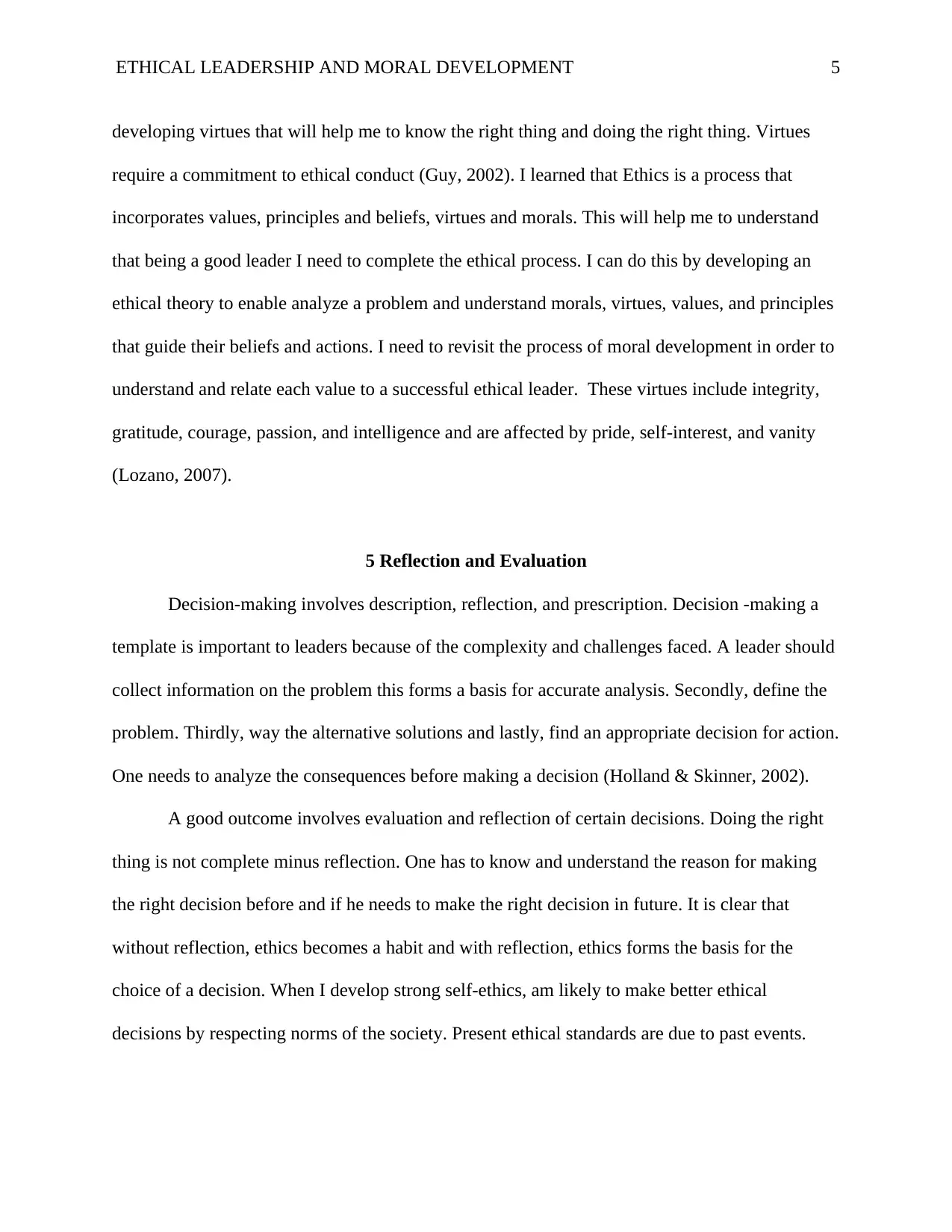
ETHICAL LEADERSHIP AND MORAL DEVELOPMENT 5
developing virtues that will help me to know the right thing and doing the right thing. Virtues
require a commitment to ethical conduct (Guy, 2002). I learned that Ethics is a process that
incorporates values, principles and beliefs, virtues and morals. This will help me to understand
that being a good leader I need to complete the ethical process. I can do this by developing an
ethical theory to enable analyze a problem and understand morals, virtues, values, and principles
that guide their beliefs and actions. I need to revisit the process of moral development in order to
understand and relate each value to a successful ethical leader. These virtues include integrity,
gratitude, courage, passion, and intelligence and are affected by pride, self-interest, and vanity
(Lozano, 2007).
5 Reflection and Evaluation
Decision-making involves description, reflection, and prescription. Decision -making a
template is important to leaders because of the complexity and challenges faced. A leader should
collect information on the problem this forms a basis for accurate analysis. Secondly, define the
problem. Thirdly, way the alternative solutions and lastly, find an appropriate decision for action.
One needs to analyze the consequences before making a decision (Holland & Skinner, 2002).
A good outcome involves evaluation and reflection of certain decisions. Doing the right
thing is not complete minus reflection. One has to know and understand the reason for making
the right decision before and if he needs to make the right decision in future. It is clear that
without reflection, ethics becomes a habit and with reflection, ethics forms the basis for the
choice of a decision. When I develop strong self-ethics, am likely to make better ethical
decisions by respecting norms of the society. Present ethical standards are due to past events.
developing virtues that will help me to know the right thing and doing the right thing. Virtues
require a commitment to ethical conduct (Guy, 2002). I learned that Ethics is a process that
incorporates values, principles and beliefs, virtues and morals. This will help me to understand
that being a good leader I need to complete the ethical process. I can do this by developing an
ethical theory to enable analyze a problem and understand morals, virtues, values, and principles
that guide their beliefs and actions. I need to revisit the process of moral development in order to
understand and relate each value to a successful ethical leader. These virtues include integrity,
gratitude, courage, passion, and intelligence and are affected by pride, self-interest, and vanity
(Lozano, 2007).
5 Reflection and Evaluation
Decision-making involves description, reflection, and prescription. Decision -making a
template is important to leaders because of the complexity and challenges faced. A leader should
collect information on the problem this forms a basis for accurate analysis. Secondly, define the
problem. Thirdly, way the alternative solutions and lastly, find an appropriate decision for action.
One needs to analyze the consequences before making a decision (Holland & Skinner, 2002).
A good outcome involves evaluation and reflection of certain decisions. Doing the right
thing is not complete minus reflection. One has to know and understand the reason for making
the right decision before and if he needs to make the right decision in future. It is clear that
without reflection, ethics becomes a habit and with reflection, ethics forms the basis for the
choice of a decision. When I develop strong self-ethics, am likely to make better ethical
decisions by respecting norms of the society. Present ethical standards are due to past events.
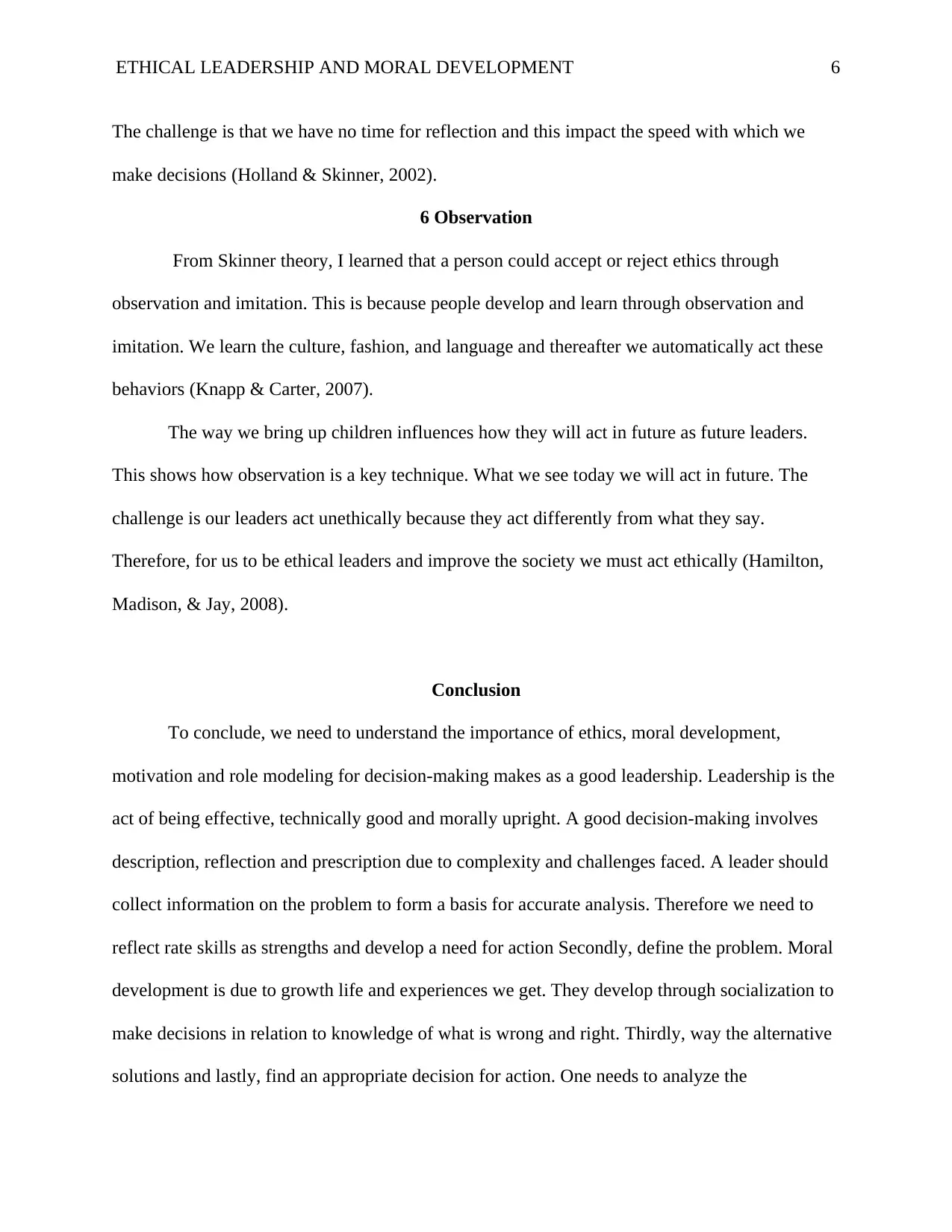
ETHICAL LEADERSHIP AND MORAL DEVELOPMENT 6
The challenge is that we have no time for reflection and this impact the speed with which we
make decisions (Holland & Skinner, 2002).
6 Observation
From Skinner theory, I learned that a person could accept or reject ethics through
observation and imitation. This is because people develop and learn through observation and
imitation. We learn the culture, fashion, and language and thereafter we automatically act these
behaviors (Knapp & Carter, 2007).
The way we bring up children influences how they will act in future as future leaders.
This shows how observation is a key technique. What we see today we will act in future. The
challenge is our leaders act unethically because they act differently from what they say.
Therefore, for us to be ethical leaders and improve the society we must act ethically (Hamilton,
Madison, & Jay, 2008).
Conclusion
To conclude, we need to understand the importance of ethics, moral development,
motivation and role modeling for decision-making makes as a good leadership. Leadership is the
act of being effective, technically good and morally upright. A good decision-making involves
description, reflection and prescription due to complexity and challenges faced. A leader should
collect information on the problem to form a basis for accurate analysis. Therefore we need to
reflect rate skills as strengths and develop a need for action Secondly, define the problem. Moral
development is due to growth life and experiences we get. They develop through socialization to
make decisions in relation to knowledge of what is wrong and right. Thirdly, way the alternative
solutions and lastly, find an appropriate decision for action. One needs to analyze the
The challenge is that we have no time for reflection and this impact the speed with which we
make decisions (Holland & Skinner, 2002).
6 Observation
From Skinner theory, I learned that a person could accept or reject ethics through
observation and imitation. This is because people develop and learn through observation and
imitation. We learn the culture, fashion, and language and thereafter we automatically act these
behaviors (Knapp & Carter, 2007).
The way we bring up children influences how they will act in future as future leaders.
This shows how observation is a key technique. What we see today we will act in future. The
challenge is our leaders act unethically because they act differently from what they say.
Therefore, for us to be ethical leaders and improve the society we must act ethically (Hamilton,
Madison, & Jay, 2008).
Conclusion
To conclude, we need to understand the importance of ethics, moral development,
motivation and role modeling for decision-making makes as a good leadership. Leadership is the
act of being effective, technically good and morally upright. A good decision-making involves
description, reflection and prescription due to complexity and challenges faced. A leader should
collect information on the problem to form a basis for accurate analysis. Therefore we need to
reflect rate skills as strengths and develop a need for action Secondly, define the problem. Moral
development is due to growth life and experiences we get. They develop through socialization to
make decisions in relation to knowledge of what is wrong and right. Thirdly, way the alternative
solutions and lastly, find an appropriate decision for action. One needs to analyze the
⊘ This is a preview!⊘
Do you want full access?
Subscribe today to unlock all pages.

Trusted by 1+ million students worldwide
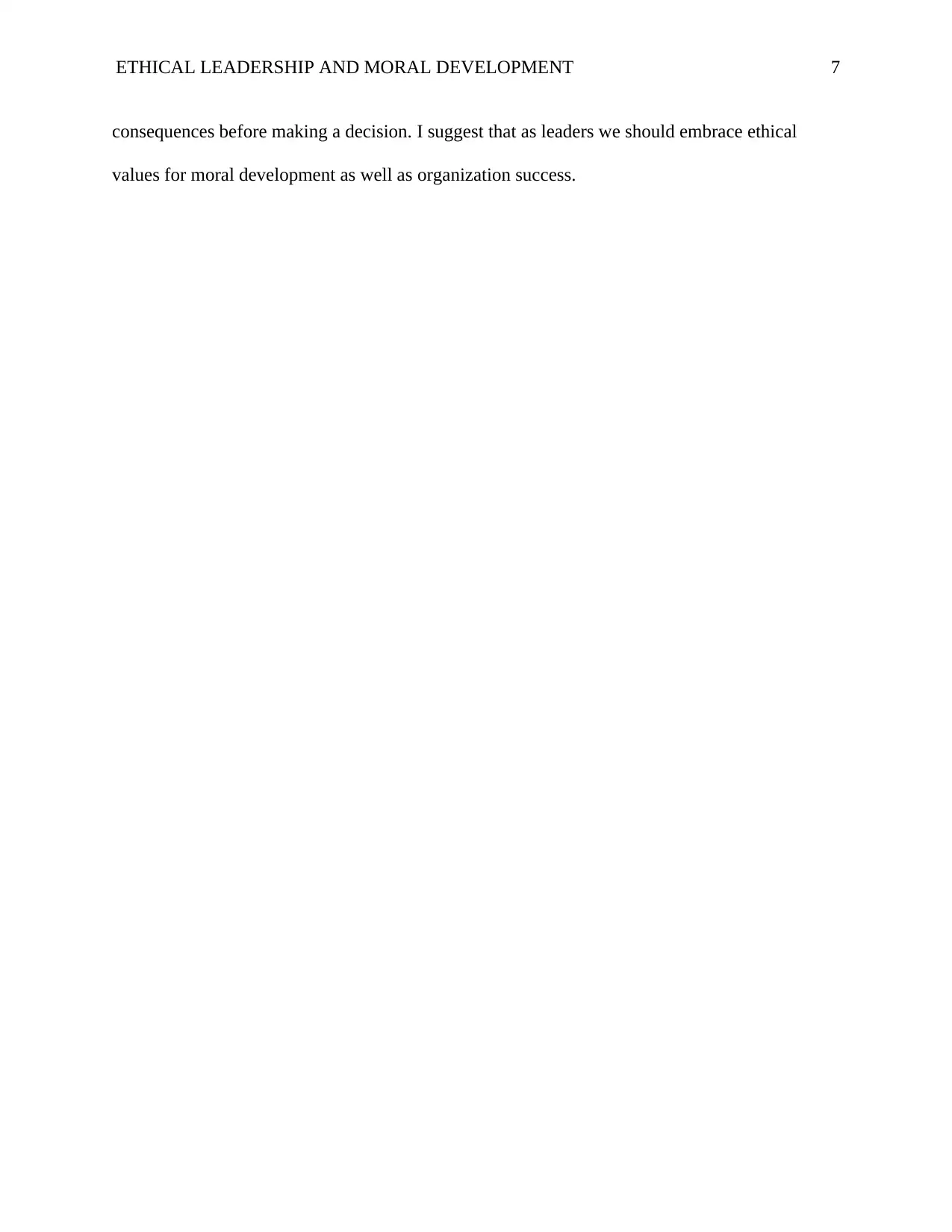
ETHICAL LEADERSHIP AND MORAL DEVELOPMENT 7
consequences before making a decision. I suggest that as leaders we should embrace ethical
values for moral development as well as organization success.
consequences before making a decision. I suggest that as leaders we should embrace ethical
values for moral development as well as organization success.
Paraphrase This Document
Need a fresh take? Get an instant paraphrase of this document with our AI Paraphraser
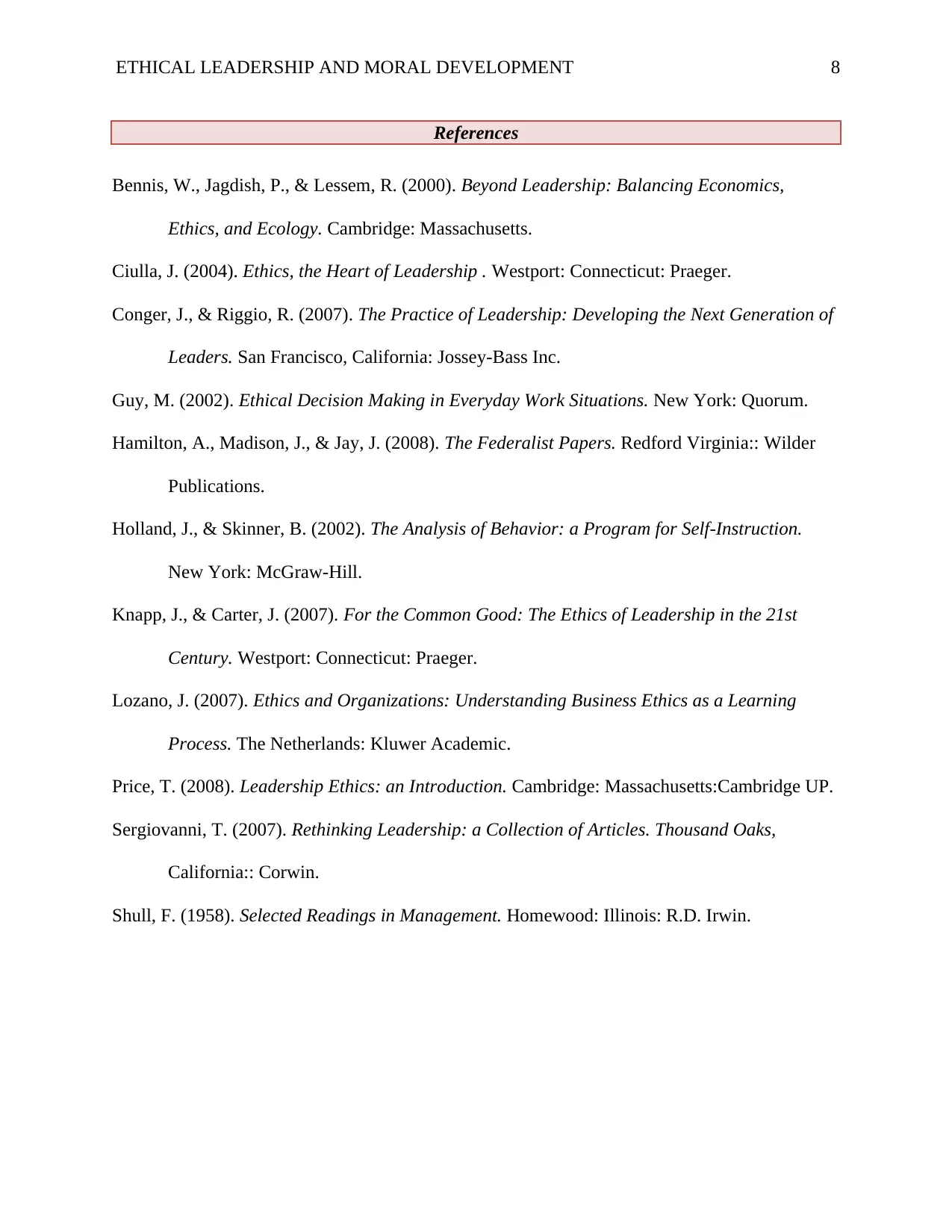
ETHICAL LEADERSHIP AND MORAL DEVELOPMENT 8
References
Bennis, W., Jagdish, P., & Lessem, R. (2000). Beyond Leadership: Balancing Economics,
Ethics, and Ecology. Cambridge: Massachusetts.
Ciulla, J. (2004). Ethics, the Heart of Leadership . Westport: Connecticut: Praeger.
Conger, J., & Riggio, R. (2007). The Practice of Leadership: Developing the Next Generation of
Leaders. San Francisco, California: Jossey-Bass Inc.
Guy, M. (2002). Ethical Decision Making in Everyday Work Situations. New York: Quorum.
Hamilton, A., Madison, J., & Jay, J. (2008). The Federalist Papers. Redford Virginia:: Wilder
Publications.
Holland, J., & Skinner, B. (2002). The Analysis of Behavior: a Program for Self-Instruction.
New York: McGraw-Hill.
Knapp, J., & Carter, J. (2007). For the Common Good: The Ethics of Leadership in the 21st
Century. Westport: Connecticut: Praeger.
Lozano, J. (2007). Ethics and Organizations: Understanding Business Ethics as a Learning
Process. The Netherlands: Kluwer Academic.
Price, T. (2008). Leadership Ethics: an Introduction. Cambridge: Massachusetts:Cambridge UP.
Sergiovanni, T. (2007). Rethinking Leadership: a Collection of Articles. Thousand Oaks,
California:: Corwin.
Shull, F. (1958). Selected Readings in Management. Homewood: Illinois: R.D. Irwin.
References
Bennis, W., Jagdish, P., & Lessem, R. (2000). Beyond Leadership: Balancing Economics,
Ethics, and Ecology. Cambridge: Massachusetts.
Ciulla, J. (2004). Ethics, the Heart of Leadership . Westport: Connecticut: Praeger.
Conger, J., & Riggio, R. (2007). The Practice of Leadership: Developing the Next Generation of
Leaders. San Francisco, California: Jossey-Bass Inc.
Guy, M. (2002). Ethical Decision Making in Everyday Work Situations. New York: Quorum.
Hamilton, A., Madison, J., & Jay, J. (2008). The Federalist Papers. Redford Virginia:: Wilder
Publications.
Holland, J., & Skinner, B. (2002). The Analysis of Behavior: a Program for Self-Instruction.
New York: McGraw-Hill.
Knapp, J., & Carter, J. (2007). For the Common Good: The Ethics of Leadership in the 21st
Century. Westport: Connecticut: Praeger.
Lozano, J. (2007). Ethics and Organizations: Understanding Business Ethics as a Learning
Process. The Netherlands: Kluwer Academic.
Price, T. (2008). Leadership Ethics: an Introduction. Cambridge: Massachusetts:Cambridge UP.
Sergiovanni, T. (2007). Rethinking Leadership: a Collection of Articles. Thousand Oaks,
California:: Corwin.
Shull, F. (1958). Selected Readings in Management. Homewood: Illinois: R.D. Irwin.
1 out of 8
Related Documents
Your All-in-One AI-Powered Toolkit for Academic Success.
+13062052269
info@desklib.com
Available 24*7 on WhatsApp / Email
![[object Object]](/_next/static/media/star-bottom.7253800d.svg)
Unlock your academic potential
Copyright © 2020–2025 A2Z Services. All Rights Reserved. Developed and managed by ZUCOL.




